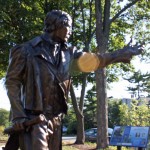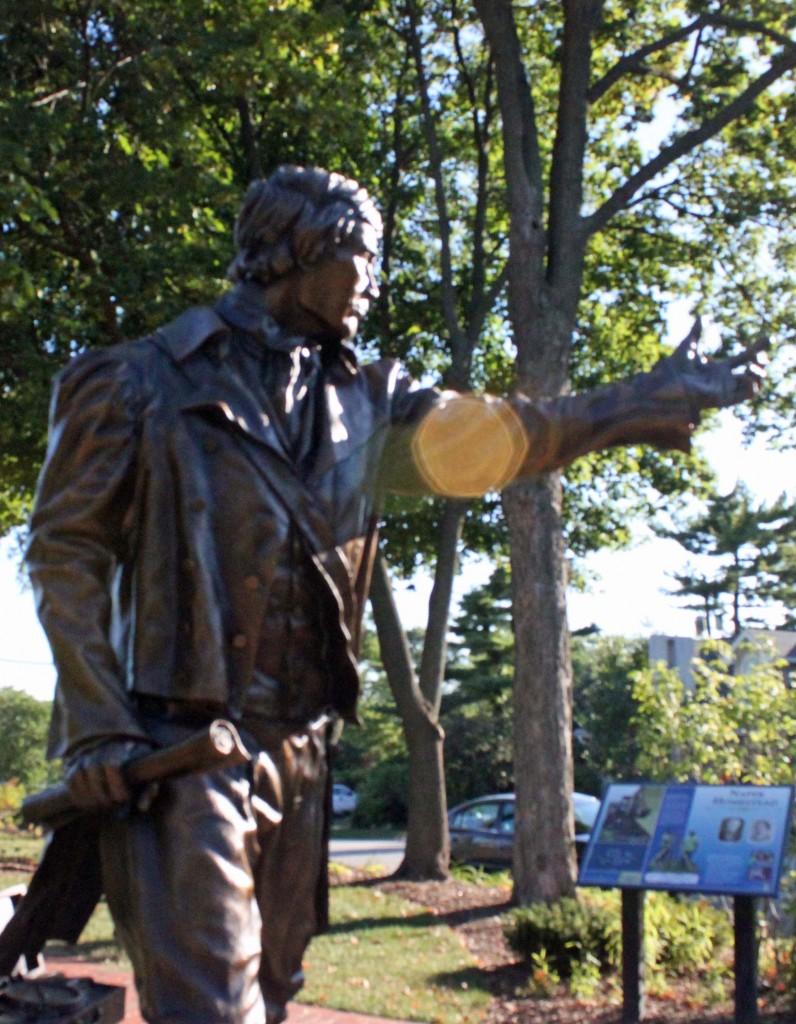Joseph Naper, the founder of Naperville is alive again, but this time, he lives in the form of a statue located near the intersection of Mill Street and Jefferson Avenue. The statue is part of the new historical park, Naper Homestead, where Naper formerly lived.
The Naperville Heritage Society/Naper Settlement partnered with nationally recognized, Pulitzer Prize-winning cartoonist and artist Dick Locher to design the image for the statue. Artist Jeff Adams then created the sculpture from Locher’s design. Locher’s previous projects include the Dick Tracy statue located along Downtown Naperville’s Riverwalk.
Locher believes that the tribute to Naper is long overdue.
“Great men get great rewards in life,” Locher said. “The president of the United States or the CEO of a business gets recognized right away. Joe Naper, who did it all thinking nothing would ever happen…we want him to become alive.”

The 9-½ foot monument crafted with 2,000 pounds of bronze represents Joseph Naper as a young 33-year-old, when he founded Naper Settlement. Next to the figure of Naper stands another bronze sculpture of a hewn tree stump with an axe and surveyor’s tools. These two structures portray the relationship between wilderness and the established settlement, according to Naper Settlement’s brochure for the statue.
The State of Illinois funded the Naperville Heritage Society/Naper Settlement $350,000 in grants to construct the self-guided historic interpretive sight, obtain exhibit signage, site artifact storage and build the statue.
Dozens of community residents attended the Joseph Naper Statue Dedication Ceremony, anxiously awaiting the statue’s unveiling. One attendee was Carolyn Lauing Finzer, Central class of 1965 and fourth-generation Napervillian. Finzer says she was thrilled to see the statue that local artists made due to her family history in the city, noting that her ancestors arrived in Naperville just 40 years after Joseph Naper’s founding in 1831.
The idea to build a historical site came in 2009, according to Bryan Ogg, Curator of Research at Naper Settlement and project manager for Naper Homestead.
“After two archaeological digs [on the site of Naper Homestead], we found Joseph Naper’s home and trading posts, we found out how he lived and who he was as an individual,” Ogg said. “As a family man, as a business man and founder of Naperville, the idea for an interpretative park came out right away.”
The park was developed in three years, and about 1 ½ years were spent creating the statue. Before making the statue, Locher first built a small, 12-inch wax model of Naper. When building the model, Locher considered Naper’s appearance, clothes and actions. The end product shows Naper sporting a pair of 1812 army boots, standing with one foot off of the ground and pointing to portray him as “a man of action.”
“Making the statue is like giving birth—you never know what’s going to happen,” Locher said. “You want the best possible delivery as it can be, [so we used] bronze, which is pretty steady. That statue has a 400-year shelf life, and we know the river won’t take it away because it won’t float.”
Locher hopes that the durability of the Naper statue will ensure that future generations remember the city’s roots. While Lochner believes Dick Tracy, whose sculpture he completed in 2010, will always be remembered as an icon, historical figures like Naper are more easily overlooked.
“People that don’t enter into history tend to forget what happened,” Locher said. “We’re reinventing a little bit of history and a lot of towns are envious of us for that.”
Finzer appreciates the history behind Joseph Naper’s journey to the Naperville area. She brought clusters and branches of Ohio Buckeyes for the dedication ceremony to symbolize good luck charms Naper carried when he voyaged across Lake Erie.
“The nut [of the Buckeye] has a brown coloration with a white spot on it,” Finzer said, handing me a nut. “You can open it up and when air touches it, it will turn brown. These were used as good luck pieces in pockets, so Captain Naper probably had one of these when he left Ashtabula, Ohio for his journey.”
Just like Finzer was left inspired, Ogg wants the viewers in awe of Naper’s determination and bravery.
“Sixty-seven people followed [Naper] out here to form this community and I think that if Joseph Naper were here today, he would be very proud of the Naperville he sees,” Ogg said.





